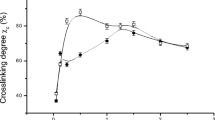Abstract
Sterilization through γ-irradiation has been reported to affect collagen mechanical properties, but its possible effects on gelatin based materials have not been investigated up to now. Herein we report the results of a mechanical, chemical and thermal study performed on gelatin films before and after γ-irradiation. The investigation was performed on uncrosslinked films as well as on crosslinked films. To this aim, two common crosslinking agents, glutaraldehyde and genipin, at different concentration (0.15, 0.30 and 0.67 %) were used. The results indicate that sterilization significantly affects the mechanical properties of uncrosslinked films, whereas it displays a modest effect on gelatin swelling, release in solution, thermal stability and molecular structure. Both glutaraldehyde and genipin enhance the mechanical properties and stability in solution of the gelatin films. In particular, the values of Young modulus increase as a function of crosslinker concentration up to about 10 and 18 MPa for genipin and glutaraldehyde treated samples respectively. The results of in vitro study demonstrate that the films crosslinked with genipin do not display any cytotoxic reaction, whereas glutaraldehyde crosslinking provokes an acute and dose dependent cytotoxic effect.








Similar content being viewed by others
References
Mano JF, Silva GA, Azevedo HS, Malafaya PB, Sousa RA, Silva SS, Boesel LF, Oliveira JM, Santos TC, Marques AP, Neves NM, Reis RL. Natural origin biodegradable systems in tissue engineering and regenerative medicine: present status and some moving trends. J R Soc Interface. 2007;4:999–1030.
Gómez-Guillén MC, Giménez B, López-Caballero ME, Montero MP. Functional and bioactive properties of collagen and gelatin from alternative sources: a review. Food Hydrocoll. 2011;25:1813–27.
Veis A. The macromolecular chemistry of gelatin. New York: Academic; 1964.
Pezron I, Djabourov M, Leblond J. Conformation of gelatin chains in aqueous solutions: 1. A light and small angle neutron scattering study. Polymer. 1991;32:3201–10.
Ross-Murphy SB. Structure and rheology of gelatin gels: recent progress. Polymer. 1992;33:2622–7.
Ackerman MS, Bhate M, Shenoy N, Beck K, Ramshaw JA, Brodsky B. Sequence dependence of the folding of collagen-like peptides single amino acids affect the rate of triple-helix nucleation. J Biol Chem. 1999;274:7668–73.
Bigi A, Panzavolta S, Rubini K. Relationship between triple helix content and mechanical properties of gelatin films. Biomaterials. 2004;25:5675–80.
Gornall JL, Terentjev EM. Helix–coil transition of gelatin: helical morphology and stability. Soft Matter. 2008;4:544–9.
Boanini E, Rubini K, Panzavolta S, Bigi A. Chemico-physical characterization of gelatin films modified with oxidized alginate. Acta Bio. 2010;6:383–8.
Hashim DM, Man YBC, Norakasha R, Shuhaimi M, Salmah Y, Syahariza ZA. Potential use of Fourier transform infrared spectroscopy for differentiation of bovine and porcine gelatins. Food Chem. 2010;118:856–60.
Noah EM, Chen J, Jiao X, Heschel I, Pallua N. Impact of sterilization on the porous design and cell behavior in collagen sponges prepared for tissue engineering. Biomaterials. 2002;23:2855–61.
Wiegand C, Abel M, Ruth P, Wilhelms T, Schulze D, Norgauer J, Hipler UC. Effect of the sterilization method on the performance of collagen type I on chronic wound parameters in vitro. J Biomed Mater Res B: Appl Biomater. 2009;90B:710–9.
Burton B, Gaspar A, Josey D, Tupy J, Grynpas MD, Willett TL. Bone embrittlement and collagen modifications due to high-dose gamma-irradiation sterilization. Bone. 2014;61:71–81.
Panzavolta S, Torricelli P, Amadori S, Parrilli A, Rubini K, Bella ED, Fini M, Bigi A. 3D interconnected porous biomimetic scaffolds: in vitro cell response. J Biom Mat Res A. 2013;101A:3560–70.
Gioffrè M, Torricelli P, Panzavolta S, Rubini K, Bigi A. Role of pH on stability and mechanical properties of gelatin films. J Bioact Compat Polymers. 2012;27:57–67.
Dong GC, Chen HM, Yao CH. A novel bone substitute composite composed of tricalcium phosphate, gelatin and drynaria fortunei herbal extract. J Biomed Mater Res. 2008;84A:167–77.
Bigi A, Bracci B, Cojazzi G, Panzavolta S, Roveri N. Drawn gelatin films with improved mechanical properties. Biomaterials. 1998;19:2335–40.
Bigi A, Cojazzi G, Panzavolta S, Roveri N, Rubini K. Stabilization of gelatin films by crosslinking with genipin. Biomaterials. 2002;23:4827–32.
Bigi A, Cojazzi G, Panzavolta S, Roveri N, Rubini K. Mechanical and thermal properties of gelatin films at different degrees of glutaraldehyde crosslinking. Biomaterials. 2001;22:763–8.
Ofner CMIII, Bubnis WA. Chemical and swelling evaluations of amino group crosslinking in gelatin and modified gelatin matrices. Pharm Res. 1996;13:1821–7.
Hataka T, Sato H, Watanabe Y, Matsumoto M. Effect of formaldehyde on the physiochemical properties of soft gelatin capsule shells. Chem Pharm Bull. 1994;42:1138–42.
Tonda-Turo C, Gentile P, Saracino S, Chiono V, Nandagiri VK, Muzio G, Canuto RA, Ciardelli G. Comparative analysis of gelatin scaffolds crosslinked by genipin and silane coupling agent. Int J Biol Macromol. 2011;49:700–6.
Tronci G, Doyle A, Russell SJ, Wood DJ. Triple-helical collagen hydrogels via covalent aromatic functionalisation with 1,3-phenylenediacetic acid. J Mater Chem B. 2013;1:5478–88.
Zhang L, Aksan A. Fourier transform infrared analysis of the thermal modification of human cornea tissue during conductive keratoplasty. Appl Spectrosc. 2010;64:23–9.
Fessel G, Cadby J, Wunderli S, van Weeren R, Snedeker JG. Dose- and time-dependent effects of genipin crosslinking on cell viability and tissue mechanics —toward clinical application for tendon repair. Acta Biomater. 2014;10(5):1897–906.
Sundararaghavan HG, Monteiro GA, Lapin NA, Chabal YJ, Miksan JR, Shreiber DI. Genipin-induced changes in collagen gels: correlation of mechanical properties to fluorescence. J Biomed Mater Res A. 2008;87(2):308–20.
Chang WH, Chang Y, Lai PH, Sung HW. A genipin-crosslinked gelatin membrane as wound-dressing material: in vitro and in vivo studies. J Biomater Sci. 2003;14(5):481–95 (Polymer Edition).
Gough JE, Scotchford CA, Downes S. Cytotoxicity of glutaraldehyde crosslinked collagen/poly(vinyl alcohol) films is by the mechanism of apoptosis. J Biomed Mater Res. 2002;61(1):121–30.
Chen DC, Lai YL, Lee SY, Hung SL, Chen HL. Osteoblastic response to collagen scaffolds varied in freezing temperature and glutaraldehyde crosslinking. J Biomed Mater Res A. 2007;80(2):399–409.
Acknowledgments
This work was financially supported by MIUR (FIRB No. RBAP10MLK7).
Author information
Authors and Affiliations
Corresponding authors
Rights and permissions
About this article
Cite this article
Amadori, S., Torricelli, P., Rubini, K. et al. Effect of sterilization and crosslinking on gelatin films. J Mater Sci: Mater Med 26, 69 (2015). https://doi.org/10.1007/s10856-015-5396-4
Received:
Accepted:
Published:
DOI: https://doi.org/10.1007/s10856-015-5396-4




